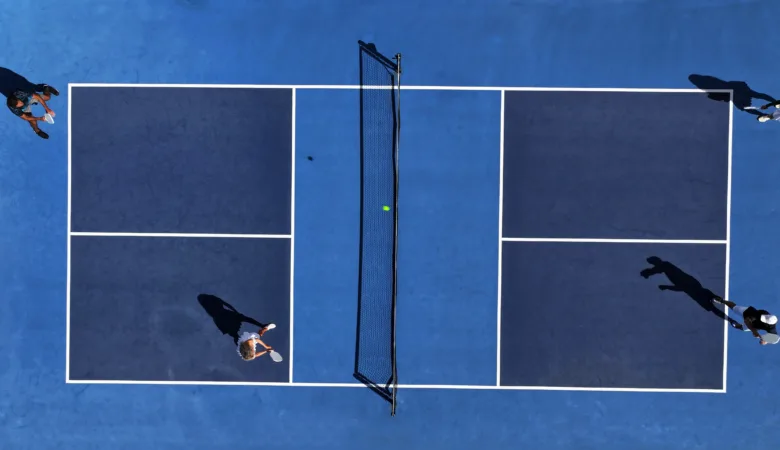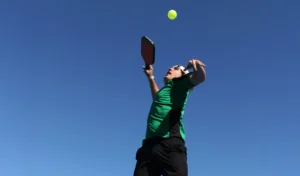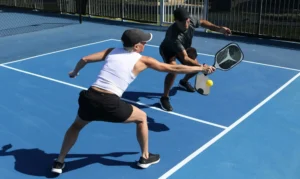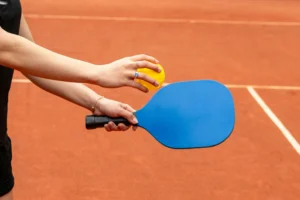
The third shot drop is one of the most critical shots in pickleball, acting as the bridge between baseline play and net dominance. If executed correctly, it neutralizes aggressive opponents, slows down the pace of the rally, and allows you to advance toward the net—the best ending position in the game of pickleball.
But mastering this shot doesn’t come from feel—it’s about science. This guide will disassemble the third shot drop, explaining it through the lens of technology and mathematical concepts, delving into the scientific calculations, angles, speeds, and highest-point details it takes to accomplish this game-ending shot.
What is the Third Shot Drop?
The third shot drop in pickleball is a soft, arching shot hit from the baseline after the serve and return (and thus the “third shot“). The goal is to drop the ball into the opponent’s kitchen (non-volley zone), preventing them from attacking and giving you time to move forward.
Unlike drives or lobs, the third shot drop is about precision, control, and arc rather than power.

The Science Behind the Perfect Third Shot Drop
Mastering the third shot drop in pickleball takes precise ball control, smart shot mechanics, and strategic execution. Improving your net game or sharpening your accuracy? Mastering the science behind this shot gives you the edge to win.
So we’re gonna learn some science material and actual data to determine the best way to shoot, such as the angle, speed, and spin mechanics, which will completely assist you in mastering this game-changing shot.
1. Understanding the Trajectory of a Third Shot Drop
You must control the ball’s arc and landing zone to execute a successful third-shot drop. The ideal shot follows a parabolic trajectory, reaching its highest point (apex) before crossing the net to ensure a smooth drop into the kitchen.
Optimal Shot Apex Height
- 1.5 – 1.8 meters (5 – 6 feet) above the ground.
- The ball should reach its peak on your side of the net to ensure a steep descent.
Ideal Net Clearance
- The ball should clear the net by 20 – 45 cm (8 – 18 inches).
- A higher clearance makes it safer but more manageable to attack.
- A lower clearance minimizes attackability but increases net faults.
Target Landing Zone
- The ball should land within the opponent’s kitchen (non-volley zone).
- Aim for 12-24 inches (30-60 cm) past the net to avoid hitting too short.
- Cross-court drops provide a more considerable margin for error compared to down-the-line shots.
Scientific Insight:
According to trajectory equations, the formula for a perfect third shot drop trajectory follows the standard projectile motion formula:
y = v₀t sin(θ) - (1/2) gt²
Where:
y= height of the ball at the timetv₀= initial velocityθ= launch angleg= acceleration due to gravity (9.8 m/s²)

Adjusting launch speed (v₀) and angle (θ) allows you to control the ball’s arc for consistent third-shot drops.
2. Optimal Shot Speed and Angles
Your third shot’s drop speed and launch angle determine its control, depth, and difficulty for your opponent.
Shot Speed
- Down-the-line shots: 10.9 – 13 m/s (24.4 – 29.1 mph).
- Cross-court shots: 13.3 – 16 m/s (29.7 – 35.8 mph) (due to increased distance).
Optimal Launch Angle
- Down-the-line shots: 15.5° – 22.5°.
- Cross-court shots: 12.5° – 18° (lower angle needed due to longer distance).
Scientific Insight
Using basic physics equations for projectile motion, the ideal launch angle can be calculated with:
θ = tan⁻¹ (4h/d)Where:
h= target height (kitchen bounce zone)d= horizontal distance to target
A higher launch angle provides more control, while a lower launch angle results in a faster-paced drop shot.
3. The Role of Spin in a Third Shot Drop
Adding topspin can increase precision and prevent attackable returns.
How does Topspin help?
- It makes the ball fall faster, reducing opportunities to attack.
It holds the ball lower following the bounce, thus making it difficult for opponents.
It increases your shot’s consistency and prevents floating shots.
Topspin Mechanics:
- Drag the paddle upwards a little upon contact.
- Sustain 200-500 RPM spin rate for best dip.
- Too much spin will change accuracy, so begin with control and speed first.
Scientific Insight:
The Magnus effect explains how topspin causes faster downward motion, making it ideal for precise third-shot drops.
The equation governing the Magnus effect:
F = S (v × ω)Where:
F= Magnus forceS= constant (depends on air resistance)v= velocity of the ballω= rotational speed (spin)
The Magnus force causes a faster downward arc, allowing topspin third shot drops to stay low and difficult to return.
4. Shot Placement Strategy for Maximum Effectiveness
Where to Aim Your Third Shot Drop?
- Cross-court Kitchen – More margin for error and a softer landing.
- Opponent’s Backhand – Harder to attack and control.
- At Their Feet – Forces a weak upward return.
When should you use a Drive instead of a Drop?
- Use a third-shot drive when your opponents are standing too far back, making it harder for them to react.
- Mix in drops and drives to keep opponents off balance.
Scientific Insight:
Data analysis of pro-level pickleball matches shows that players who mix drops and drives have a higher rally success rate.
Win Rate with Drops Alone = 68% Win Rate with Mixed Strategy = 81%
This suggests that while third shot drops are crucial, incorporating occasional drives keeps opponents guessing and leads to a higher win percentage.
Final Takeaways: The Science-Backed Third Shot Drop Formula
- Apex before the net – 1.5 – 1.8 meters (5 – 6 feet) high.
- Clear the net by 20 – 45 cm (8 – 18 inches) to minimize attack risk.
- Use optimal shot speed: 10.9 – 16 m/s (24.4 – 35.8 mph), depending on the shot type.
- Adjust launch angle: 12.5° – 22.5° for precision.
- Use topspin for better control, applying 200-500 RPM rotation.
- Mix in occasional drives to maintain unpredictability and increase the win rate.
The Mechanics of a Perfect Third Shot Drop
1. Grip and Paddle Position
- Use the continental grip (same as a handshake grip) for better touch and versatility.
- Keep your paddle face slightly open to lift the ball over the net with control.
- Grip pressure: Hold the paddle at about 4/10 tightness—too tight, and you lose touch; too loose, and control suffers.
2. Stance and Footwork
- Balanced stance: Feet shoulder-width apart, knees slightly bent.
- Weight transfer: Shift from back foot to front foot for control.
- Move forward immediately after executing the shot—don’t admire your work!
3. Swing Motion & Contact Point
- Contact point: Knee-level in front of your body.
- Swing motion: Smooth and controlled—no excessive force.
- Follow-through: Finish with the paddle pointing toward the target, ensuring accuracy.
Common Third Shot Drop Mistakes – How to Fix Them!
1. Hitting Too Hard
- Problem: The ball flies past the kitchen, allowing opponents to attack.
- Fix: Use soft hands, minimize wrist movement, and focus on arc over power.
2. Hitting Into the Net
- Problem: The ball doesn’t clear the net, resulting in an easy fault.
- Fix: Open the paddle face slightly more and follow through upward, not forward.
3. Floating the Ball Too High
- Problem: The ball becomes an easy target for opponents to smash.
- Fix: Reduce the paddle angle slightly and gently topspin to lower the ball.
4. Not Advancing After the Shot
- Problem: You remain at the baseline, giving up court position.
- Fix: Move forward immediately after hitting the shot—don’t wait!
Advanced Third Shot Drop Techniques
1. Adding Topspin for Control
- Why? Topspin helps the ball dip faster into the kitchen.
- How? Brush upward on the ball slightly as you make contact.
2. Shot Disguise
- Why? Keeping your swing identical for drops and drives makes you unpredictable.
- How? Use the same backswing for both, making last-second adjustments.
3. Strategic Targeting
- Why? Placement is everything.
- How?
- Cross-court drops provide more margin for error.
- Target opponent’s backhand (typically weaker side).
- Aim at their feet to force a difficult return.
Drills to Improve Your Third Shot Drop
1. Wall Drills
Stand 10 feet from a wall and hit controlled drops, aiming for a specific height.
2. Partner Drop Drills
Have a partner stand at the net and feed you balls while you practice dropping them into the kitchen.
3. Target Practice
Place cones or markers in the kitchen and aim to land your shots consistently within them.
4. Live Game Simulation
Play matches where you must use a third shot drop before advancing—forces discipline.
FAQs About Third Shot Drop in the Pickleball
What is the third shot drop in pickleball?
The third shot drop is a soft, arching shot hit from the baseline on the third shot of a rally (after the serve and return). The goal is to make the ball land in the opponent’s kitchen (non-volley zone), forcing them into a defensive position and allowing them to move to the net.
Why is the third shot drop so significant?
- It allows you to move forward – Most points in pickleball are won at the net.
- It neutralizes your opponent – A well-placed drop shot forces them to hit upward, making it harder for them to attack.
- It controls the pace – Instead of a fast rally from the baseline, the drop shot slows the game down to your advantage.
What is the best trajectory for a third-shot drop?
A successful third shot drop should Reach its highest point (apex) before crossing the net at around 1.5 – 1.8 meters (5 – 6 feet) above the ground. Clear the net by 20 – 45 cm (8 – 18 inches) to avoid easy attacks. Land in the kitchen (non-volley zone) to prevent opponent smashes.
What is the ideal speed for a third shot drop?
- Down-the-line shot: 10.9 – 13 m/s (24.4 – 29.1 mph)
- Cross-court shot: 13.3 – 16 m/s (29.7 – 35.8 mph)
How do I prevent my third shot drop from entering the net?
Use a slightly open paddle face to generate an upward lift. Focus on a smooth, controlled swing rather than a sharp hit. Aim higher than you think—it is better to be slightly high than into the net.
Why do my third shot drops float too high and get smashed?
If your drops are too high, they become attackable by your opponents. To fix this, Reduce the paddle angle slightly to lower the ball’s arc. Use a gentle topspin to help the ball dip faster after crossing the net. Focus on precision over power—a soft touch is better than an aggressive shot.
Where should I aim my third shot drop?
Best targets for third shot drops:
- Cross-court kitchen – More margin for error and a longer drop distance. The opponent’s backhand is usually their weaker shot.
- At their feet – Harder to return effectively.
Should I always use a third-shot drop?
Not necessarily! While the third shot drop is a key strategy, mixing in other shots based on your opponent’s positioning is important. Here’s when to switch things up:
- Use a third-shot drive. If your opponents are playing too far back, a well-placed drive can force them into a defensive position and put them under pressure.
- Try a lob – If your opponents are leaning too far forward at the net, a lob can send them scrambling backward, giving you time to take control of the point.
By mixing up your third shot strategy, you stay unpredictable and force your opponents to adjust, increasing your chances of winning the rally.
What’s the best grip for a third-shot drop?
Use the Continental grip (handshake grip). It provides Better control over the ball, the flexibility to hit soft drop shots or more challenging drives, and an easier way to adjust for different shots without changing grip.
How can I practice and improve my third shot drop?
Best drills to build consistency:
- Wall Drill – Stand 10 feet away from a wall and hit drop shots, keeping them controlled.
- Target Practice – Place cones in the kitchen and aim to land the ball near them.
- Live Simulation – Play practice games where you must use a third shot drop before advancing.
- Partner Drill – Have a partner at the net who returns your shots while you focus on soft, controlled drops.
How do I move forward after a third shot drop?
When you hit the shot, start advancing to the net immediately. Keep your paddle up and be ready for the next shot. If your shot is too high, pause before rushing forward to avoid being attacked.
Can I add spin to my third shot drop?
Yes! Adding topspin can Help the ball dip faster into the kitchen, make it harder for opponents to attack, and keep the ball lower after the bounce. To add topspin, brush up slightly on the ball during contact.
When should I use a third shot drive instead of a drop?
Use a third-shot drive when your opponents stand too far back, allowing you to attack. Your good forehand drive can put pressure on them. You want to mix up shots and keep your opponents guessing.
How does wind affect the third shot drop?
If you’re playing against the wind, add power to ensure the ball reaches the kitchen. With the wind at your back, use a higher arc and a softer touch to keep the shot under control.
What are the players’ biggest mistakes with the third shot drop?
Many players struggle with the third shot drop because they focus on power instead of control. However, mastering this shot requires precision, patience, and strategy. Below are the most common mistakes and how to fix them:
- Swinging too fast: The third shot drop is all about precision, not power. If you swing too fast, the ball becomes challenging to control. Instead, focus on a smooth, controlled motion to improve accuracy.
- Not moving forward: The primary purpose of this shot is to transition to the net. You lose the advantage if you stay at the baseline after hitting it. Therefore, always move forward immediately to take control of the point.
- Over-hitting the ball: Many players rely on speed rather than touch, often resulting in high, attackable shots. Instead, use a soft touch to drop the ball into the kitchen, making it harder for your opponent to return.
- Being too predictable: Repeating the same shot time and time makes it easier for your opponents to anticipate and counter. Vary your shots by altering depth, spin, and placement to keep them guessing, and you’ll gain the upper hand in rallies.
If you practice control, movement, and shaking things up, you’ll master the third shot drop and employ it as a great offensive tool to take your pickleball game to the next level.
Final Thoughts: The Key Takeaways
- Keep it soft & controlled—power isn’t the goal.
- Aim for the kitchen—no high floaters!
- Move forward immediately—transition to net dominance.
- Master arc & placement—consistency wins games.
- Practice with purpose—drills build muscle memory.
The third shot drop can make or break your game. Master it, and you dictate the pace, control the rally, and set yourself up for victory.
Now, get on the court and start dropping it like a pro!


